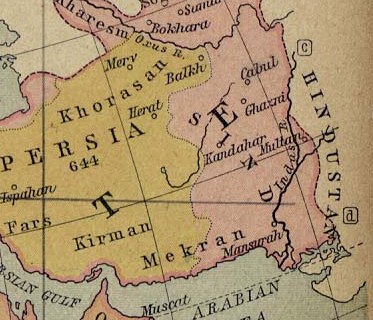 |
This is a file from the Wikimedia Commons. Information from its description page there is shown below.
Commons is a freely licensed media file repository. You can help.
|
| Description |
Map showing Ancient Persia in light yellowish and the the land called Sind (most of today's Afghanistan and part of Pakistan) in pinkish. A number of ancient references are made to the names shown in this map. Ibn Batutta writes in 1333 AD:
"We travelled from there to Naysabur, one of the four capitals of Khurasan.... We travelled thence to Parwan, where I met the amir Buruntayh. He treated me well and wrote to his representatives at Ghazna enjoining them to show me honour. We went on to the village of Charkh [Charikar], it being now summer, and from there to the town of Ghazna. This is the town of the famous warrior-sultan Mahmud ibn Sabuktagin, one of the greatest of rulers, who made frequent raids into India and captured cities and fortresses there. His grave is in this city and is surmounted by a hospice. The greater part of the town is in ruins and nothing but a fraction of it remains, though it was once a large city. It has an exceedingly cold climate, and the inhabitants move from it in the cold season to Qandahar, a large and prosperous town three nights journey from Ghazna, but I did not visit it. We travelled on to Kabul, formerly a vast town, the site of which is now occupied by a village inhabited by a tribe of Persians called Afghans. They hold mountains and defiles and possess considerable strength, and are mostly highwaymen. Their principle mountain is called Kuh Sulayman... From Kabul we rode to Karmash, which is a fortress belonging to the Afghans... On reaching Sind I followed this practice and bought horses, camels, white slaves and other goods from the merchants. I had already bought from an Iraqi merchant in Ghazna about thirty horses and a camel with a load of arrows, for this is one of the things presented to the sultan. This merchant went off to Khurasan and on returning to India received his money from me. After crossing the river of Sind called Panj Ab, our way led through a forrest of reeds, in which I saw a rhinoceros for the first time. After two days' march we reached Janani, a large and fine town on the bank of the river Sind. Its people are a people called the Samira, whose ancestors established themselves there on the conquest of Sind in the time of al-Hajjaj [712 A.D.]"
|
| Date |
1926 |
| Source |
University of Texas at Austin, Middle East and Europe - The Caliphate in 750 (293K) |
| Author |
William R. Shepherd |
Permission
( Reusing this file) |
| Public domainPublic domainfalsefalse |
 |
This image (or other media file) is in the public domain because its copyright has expired.
This applies to Australia, the European Union and those countries with a copyright term of life of the author plus 70 years.
 You must also include a United States public domain tag to indicate why this work is in the public domain in the United States. Note that a few countries have copyright terms longer than 70 years: Mexico has 100 years, Colombia has 80 years, and Guatemala and Samoa have 75 years, Russia has 74 years for some authors. This image may not be in the public domain in these countries, which moreover do not implement the rule of the shorter term. Côte d'Ivoire has a general copyright term of 99 years and Honduras has 75 years, but they do implement the rule of the shorter term. You must also include a United States public domain tag to indicate why this work is in the public domain in the United States. Note that a few countries have copyright terms longer than 70 years: Mexico has 100 years, Colombia has 80 years, and Guatemala and Samoa have 75 years, Russia has 74 years for some authors. This image may not be in the public domain in these countries, which moreover do not implement the rule of the shorter term. Côte d'Ivoire has a general copyright term of 99 years and Honduras has 75 years, but they do implement the rule of the shorter term.
|
|
This file has been identified as being free of known restrictions under copyright law, including all related and neighboring rights.
|
|
File usage
The following pages on Schools Wikipedia link to this image (list may be incomplete):
This file contains additional information, probably added from the digital camera or scanner used to create or digitize it. If the file has been modified from its original state, some details may not fully reflect the modified file.
Wikipedia for Schools brings Wikipedia into the classroom. In 133 nations around the world, SOS Childrens Villages works to bring better education and healthcare to families in desperate need of support. Why not try to learn more about child sponsorship?



